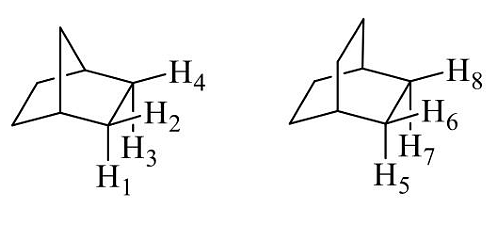Question:
Which of the following statements is true about a chiral carbon?
Which of the following statements is true about a chiral carbon?
Show Hint
A chiral carbon is defined by its attachment to four different groups. This asymmetry leads to chirality, which is fundamental in stereochemistry.
Updated On: Apr 12, 2025
- A chiral carbon is attached to two identical groups.
- A chiral carbon must be attached to four different groups.
- A chiral carbon cannot exist in molecules with symmetry.
- A chiral carbon is always part of an alkene.
Hide Solution
Verified By Collegedunia
The Correct Option is B
Solution and Explanation
A chiral carbon is a carbon atom that is attached to four different groups. This gives rise to chirality, which results in non-superimposable mirror images, or enantiomers. A molecule with a chiral carbon is asymmetric and does not have symmetry.
- Option (A) is incorrect because a chiral carbon cannot be attached to two identical groups, as this would create a plane of symmetry, making the carbon achiral.
- Option (C) is incorrect because chiral carbons can exist in molecules with symmetry, as long as they are attached to four different groups.
- Option (D) is incorrect because a chiral carbon is not always part of an alkene; it can be part of many other types of molecules as well. Therefore, the correct answer is option (B).
- Option (C) is incorrect because chiral carbons can exist in molecules with symmetry, as long as they are attached to four different groups.
- Option (D) is incorrect because a chiral carbon is not always part of an alkene; it can be part of many other types of molecules as well. Therefore, the correct answer is option (B).
Was this answer helpful?
0
0
Top Questions on Chirality & symmetry of organic molecules with or without chiral centres
- Which of the following molecules is chiral in nature?
- CBSE CLASS XII - 2025
- Chemistry
- Chirality & symmetry of organic molecules with or without chiral centres
- In the given molecule,

the number of chiral centers is _______.- IIT JAM BT - 2024
- Chemistry
- Chirality & symmetry of organic molecules with or without chiral centres
- The correct statement(s) about the relationship for the H-atoms in the following compounds is (are) :

- GATE CY - 2024
- Organic Chemistry
- Chirality & symmetry of organic molecules with or without chiral centres
- Among the following, the chiral compound is

- GATE CY - 2024
- Organic Chemistry
- Chirality & symmetry of organic molecules with or without chiral centres
Questions Asked in MHT CET exam
- There are 6 boys and 4 girls. Arrange their seating arrangement on a round table such that 2 boys and 1 girl can't sit together.
- MHT CET - 2025
- permutations and combinations
- How many molecules of carbon dioxide are formed when 0.6 g carbon is burnt in air?
- MHT CET - 2025
- Stoichiometry and Stoichiometric Calculations
- What is the energy stored in a capacitor of capacitance \( C = 10 \, \mu\text{F} \) when a potential difference of \( V = 20 \, \text{V} \) is applied across it?
- MHT CET - 2025
- Electrostatic potential
- Two charges of \( +2 \, \mu\text{C} \) and \( -2 \, \mu\text{C} \) are placed 1 meter apart. What is the force between them?
- MHT CET - 2025
- coulombs law
- A thin spherical shell of radius \( 0.5 \, \text{m} \) and mass \( 2 \, \text{kg} \) is rotating about its axis of symmetry with an angular velocity of \( 10 \, \text{rad/s} \). What is its moment of inertia?
- MHT CET - 2025
- Rotational motion
View More Questions